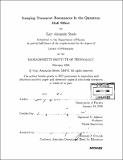| dc.contributor.advisor | Raymond C. Ashoori. | en_US |
| dc.contributor.author | Steele, Gary Alexander | en_US |
| dc.contributor.other | Massachusetts Institute of Technology. Dept. of Physics. | en_US |
| dc.date.accessioned | 2008-02-28T16:23:52Z | |
| dc.date.available | 2008-02-28T16:23:52Z | |
| dc.date.copyright | 2006 | en_US |
| dc.date.issued | 2006 | en_US |
| dc.identifier.uri | http://dspace.mit.edu/handle/1721.1/34401 | en_US |
| dc.identifier.uri | http://hdl.handle.net/1721.1/34401 | |
| dc.description | Thesis (Ph. D.)--Massachusetts Institute of Technology, Dept. of Physics, 2006. | en_US |
| dc.description | MIT Institute Archives copy: p. 201-231 bound in reverse order. | en_US |
| dc.description | Includes bibliographical references (p. 213-231). | en_US |
| dc.description.abstract | We image charge transport in the quantum Hall effect using a scanning charge accumulation microscope. Applying a DC bias voltage to the tip induces a highly resistive ring-shaped incompressible strip (IS) in a very high mobility 2D electron system (2DES). The IS moves with the tip as it is scanned, and acts as a barrier that prevents charging of the region under the tip. At certain tip positions, short-range disorder in the 2DES creates a quantum dot island inside the IS that enables breaching of the IS barrier by means of resonant tunneling through the island. Striking ring shapes appear in the images that directly reflect the shape of the IS created in the 2DES by the tip. Through the measurements of leakage across the IS, we extract information about energy gaps in the quantum Hall system. Varying the magnetic field, the tunneling resistance of the IS varies significantly, and takes on drastically different values at different filling factors. Measuring this tunneling resistance provides a unique microscopic probe of energy gaps in the quantum Hall system. Simulations of the interaction of the tip with the quantum Hall liquid show that native disorder from remote ionized donors can create the islands. The simulations predict the shape of the IS created in the 2DES in the presence of disorder, and comparison of the images with simulation results provides a direct and quantitative view of the disorder potential of a very high mobility 2DES. We also draw a connection to bulk transport. At quantum Hall plateaus, electrons in the bulk are localized by a network of ISs. | en_US |
| dc.description.abstract | We have observed that the conductance across one IS is drastically enhanced by resonant tunneling through quantum dot islands. Similarly, this resonant tunneling process will dramatically enhance the conductance of certain hopping paths in the localized bulk and could play an important role in dissipative transport at quantum Hall plateaus. | en_US |
| dc.description.statementofresponsibility | by Gary Alexander Steele. | en_US |
| dc.format.extent | 231 p. | en_US |
| dc.language.iso | eng | en_US |
| dc.publisher | Massachusetts Institute of Technology | en_US |
| dc.rights | M.I.T. theses are protected by copyright. They may be viewed from this source for any purpose, but reproduction or distribution in any format is prohibited without written permission. See provided URL for inquiries about permission. | en_US |
| dc.rights.uri | http://dspace.mit.edu/handle/1721.1/34401 | en_US |
| dc.rights.uri | http://dspace.mit.edu/handle/1721.1/7582 | |
| dc.subject | Physics. | en_US |
| dc.title | Imaging transport resonances in the quantum Hall effect | en_US |
| dc.type | Thesis | en_US |
| dc.description.degree | Ph.D. | en_US |
| dc.contributor.department | Massachusetts Institute of Technology. Department of Physics | |
| dc.identifier.oclc | 70215154 | en_US |
